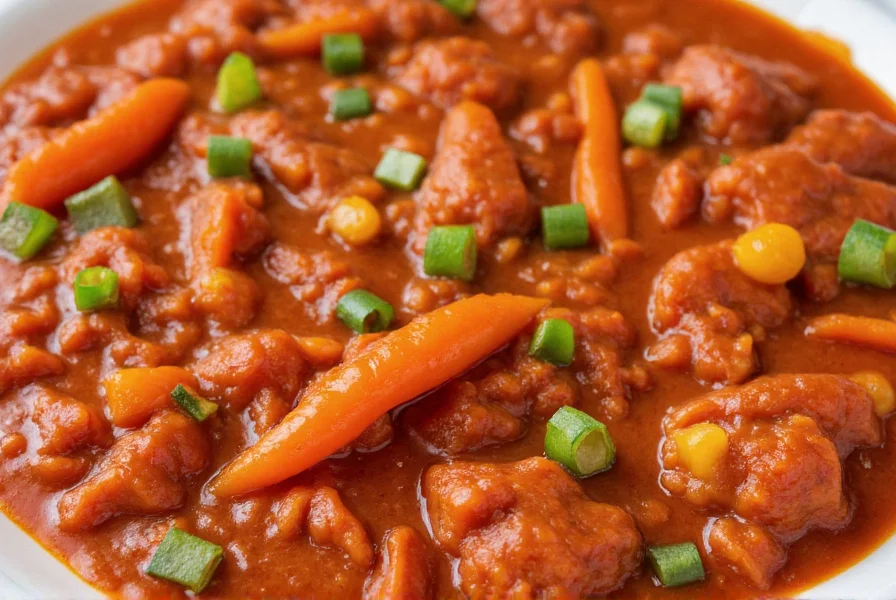Chili is one of America's most beloved comfort foods, with regional variations spanning from Texas-style meat-only versions to Cincinnati-style with chocolate undertones. A well-crafted chili balances savory, sweet, and spicy elements while achieving the perfect texture through proper simmering techniques.
The Essential Components of Perfect Chili
Creating exceptional chili requires attention to three critical elements: ingredient quality, spice balance, and cooking technique. The foundation starts with selecting fresh aromatics and quality proteins. While ground beef remains the most popular choice, chuck roast cut into small cubes provides superior texture and flavor when properly browned.

Classic Beef Chili Recipe
This authentic chili recipe has been perfected through decades of kitchen testing and delivers consistent results every time. The secret lies in the layering of flavors and proper simmering time.
Ingredients
- 2 lbs ground beef (80% lean)
- 1 large yellow onion, finely diced
- 1 bell pepper, finely diced
- 4 cloves garlic, minced
- 2 (15oz) cans kidney beans, drained and rinsed
- 1 (28oz) can crushed tomatoes
- 1 (6oz) can tomato paste
- 2 cups beef broth
- 2 tbsp chili powder
- 1 tbsp ground cumin
- 1 tsp smoked paprika
- 1 tsp dried oregano
- 1/2 tsp cayenne pepper (adjust to taste)
- Salt and black pepper to taste
Step-by-Step Preparation
- Brown the ground beef in a large pot over medium-high heat, breaking into small chunks
- Remove excess fat, leaving about 1 tablespoon for cooking vegetables
- Add onions and bell peppers, sauté until softened (5-7 minutes)
- Stir in garlic and all spices, cooking for 1 minute until fragrant
- Add tomato paste and cook for 2 minutes, stirring constantly
- Pour in crushed tomatoes, beef broth, and kidney beans
- Bring to a gentle boil, then reduce heat to low
- Cover and simmer for 60-90 minutes, stirring occasionally
- Adjust seasoning with salt, pepper, and additional spices as needed
| Cooking Stage | Time | Temperature | Key Action |
|---|---|---|---|
| Browning meat | 8-10 minutes | Medium-high | Develop fond, remove excess fat |
| Sautéing vegetables | 5-7 minutes | Medium | Softened but not browned |
| Simmering | 60-90 minutes | Low | Gentle bubbles, occasional stirring |
Variations for Different Dietary Preferences
Modern chili recipes accommodate various dietary needs while maintaining authentic flavor profiles. For vegetarian chili, substitute the beef with 2 cups of cooked lentils and an additional can of black beans. Add 1 cup of diced mushrooms for umami depth. Turkey chili works well with ground turkey and a splash of liquid smoke for richness. Those seeking slow cooker chili instructions can transfer the sautéed ingredients to a crockpot and cook on low for 6-8 hours.
Serving Suggestions and Garnishes
The perfect chili experience extends beyond the pot. Serve hot chili in pre-warmed bowls with these traditional accompaniments:
- Freshly grated cheddar cheese
- Sour cream or Greek yogurt
- Chopped green onions
- Crushed tortilla chips
- Lime wedges for brightness
- Avocado slices for creaminess

Storage and Reheating Guidelines
Chili's flavors deepen when stored properly. Cool completely before transferring to airtight containers. Refrigerated chili maintains quality for 4-5 days, while frozen portions last up to 3 months. When reheating, add a splash of broth or water to restore ideal consistency. For best results, thaw frozen chili overnight in the refrigerator before reheating.
Troubleshooting Common Chili Problems
Even experienced cooks encounter challenges with chili preparation. If your chili is too thin, create a slurry with 1 tablespoon cornstarch mixed with 2 tablespoons cold water, then stir into the simmering chili. For spicy chili that's too hot, add a tablespoon of sugar or a splash of dairy like sour cream. If flavors seem flat, boost with additional acid (a squeeze of lime) or umami (a dash of Worcestershire sauce). Remember that chili always tastes better the next day as flavors continue to meld.
Frequently Asked Questions
How can I make my chili less spicy without losing flavor?
Add dairy products like sour cream or yogurt when serving, or incorporate a small amount of sugar or honey during cooking. Beans and extra tomatoes can also help balance heat while maintaining texture and flavor complexity.
What's the difference between chili powder and chili seasoning?
Chili powder is primarily ground dried chilies, while chili seasoning contains additional spices like cumin, garlic powder, and oregano. For authentic flavor control, use pure chili powder and add individual spices separately.
Can I make authentic chili in an Instant Pot?
Yes, but with adjustments. Brown meat and sauté vegetables using the sauté function first, then pressure cook for 15 minutes with natural release. However, traditional stovetop simmering develops deeper flavors through gradual reduction that pressure cooking cannot replicate.
Why does my chili taste bland even with plenty of spices?
Spices need proper activation. Toasting whole spices before grinding or blooming ground spices in oil for 1-2 minutes before adding liquids unlocks their full flavor potential. Also ensure adequate salt, which enhances all other flavors in the dish.
How do I achieve the perfect chili consistency?
The ideal chili should mound slightly when spooned but still flow slowly. If too thin, simmer uncovered to reduce or add a cornstarch slurry. If too thick, gradually incorporate broth or tomato juice until reaching desired texture.











 浙公网安备
33010002000092号
浙公网安备
33010002000092号 浙B2-20120091-4
浙B2-20120091-4